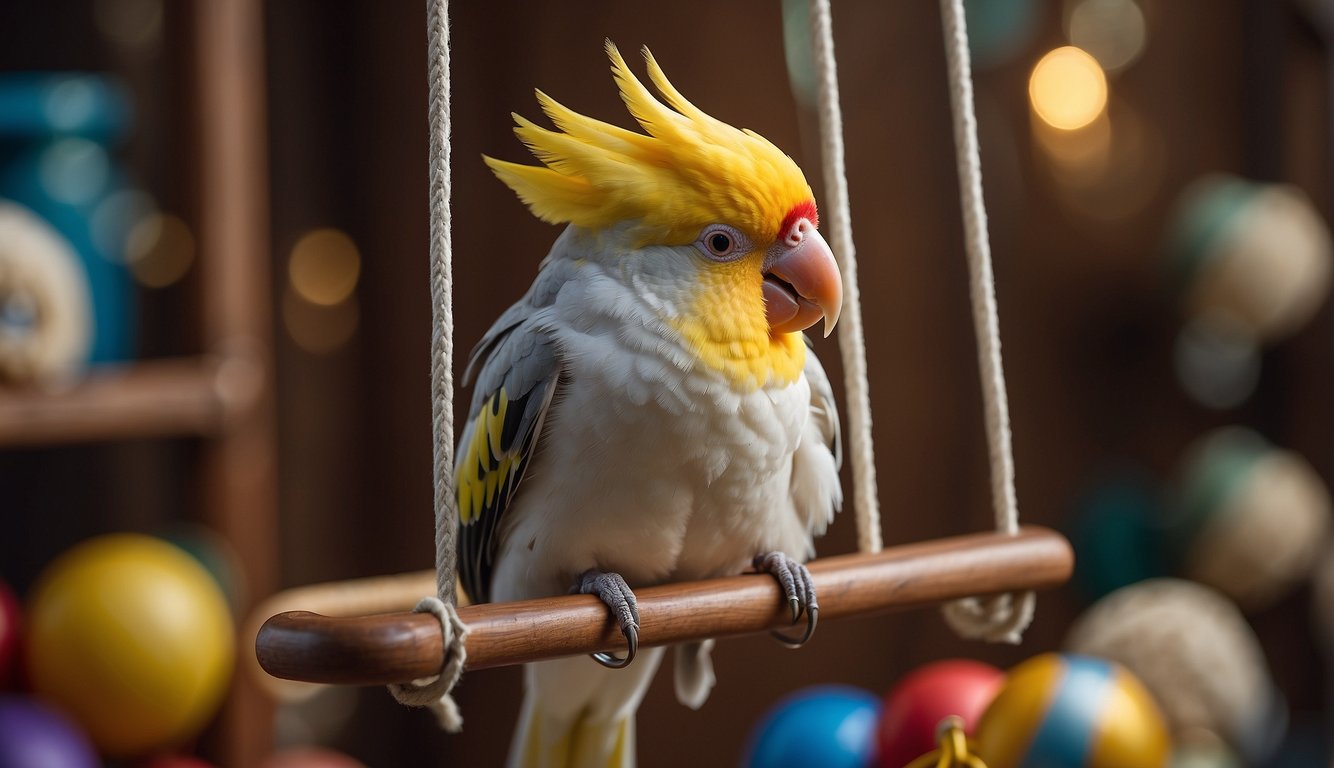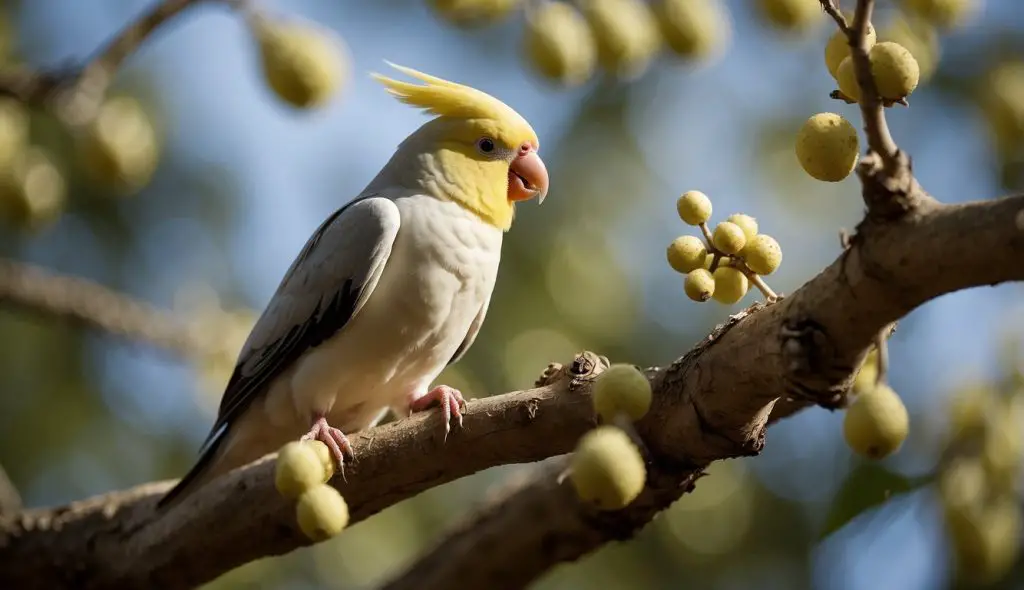Do Cockatiels Use Their Feet to Eat? Understanding Your Pet Bird’s Feeding Habits

Cockatiels are an intriguing species within the parrot family known for their distinctive crests and pleasant demeanor, frequently becoming beloved feathered companions in households. A fascinating aspect of their behavior is how they interact with food.
Unlike some birds that do not use their feet for feeding, cockatiels exhibit a notable dexterity with their feet when it comes to eating.
This adaptability reflects their evolutionary traits where although not all fine motor tasks are foot-oriented, there is a natural propensity for cockatiels t
o employ their feet when exploring and consuming their meals.

Understanding how cockatiels feed is not just a matter of curiosity but also has implications for their care. A well-rounded diet is crucial for their health, and observing their eating habits can provide insights into any nutritional needs or preferences they might have.
The environment also plays a significant role in their feeding behavior. Providing enrichment through foraging opportunities can improve their physical and psychological well-being, ensuring that their innate behaviors are supported even in captivity.
By paying close attention to the way cockatiels use their feet in feeding, caregivers can enhance their care regimen and promote a better quality of life for these social birds.
Key Takeaways
- Cockatiels use their feet to handle food, reflecting their natural behaviors.
- Observing feeding can inform about their dietary needs and preferences.
- Enriched environments support their behavioral health and well-being.
Cockatiel Feeding Behaviors
In discussing the dietary habits of cockatiels, it’s fascinating to note that while these birds do not typically use their feet to eat, they exhibit a variety of other feeding techniques.
Use of Feet in Eating
My observations indicate that cockatiels usually don’t employ their feet when eating. They have developed alternative methods of feeding, most notably using their strong, curved beak to grasp and manipulate their food. It’s important to point this out as it differentiates them from some other parrot species that may use their feet as tools while eating.
Different Feeding Techniques
Cockatiels exhibit several interesting foraging behaviors. Their diet consists primarily of seeds, but also includes an array of fruits, vegetables, and various types of grains. They have adapted their beak to crack open seed hulls efficiently. When foraging, they may be seen picking at these foods, using their beak precision to eat:
- Seeds: Expertly shelling sunflower and millet seeds with their beak.
- Fruits & Vegetables: Pecking at offered fruits like apples and leafy greens.
- Grains: Consuming grains such as wheat and oat directly, without the use of feet.
It’s incredibly engaging to watch these birds navigate their meals, showcasing their natural behaviors even within the confines of captivity.
Nutritional Requirements and Diet
In my experience caring for cockatiels, I’ve found that their diet is a crucial factor for maintaining their health. A balanced diet ensures they get the necessary vitamins, minerals, and proteins they require to thrive.
Seeds and Pellets as Staples
While seeds can be an important part of a cockatiel’s diet, they should not be the sole food source due to potential imbalances. Pellets are formulated to provide a more complete nutritional profile, including essential vitamins and minerals.
- Seeds: A mix of seeds should be offered in moderation; they are rich in fats which can lead to health issues if overfed.
- Pellets: Pellets are a staple that I recommend because they are designed to meet the dietary requirements of cockatiels, including vitamin A, calcium, and iron.
Importance of Fruits and Vegetables
Fruits and vegetables offer vital nutrients that seeds and pellets might lack and should be included in a daily diet.
- Fruits: Offer a range of fruits; they are a great source of vitamins. However, fruit should be given sparingly due to high sugar content.
- Vegetables: Introduce a variety of vegetables to provide essential vitamins and minerals. Dark leafy greens are particularly beneficial for their calcium content.
In my practice, ensuring a diet rich in pellets, complimented by a variety of seeds, fruits, and vegetables, has shown to be effective in promoting my cockatiels’ health and longevity.
Health and Wellbeing

Maintaining my cockatiel’s health and wellbeing involves a thorough understanding of their nutritional needs and the importance of regular veterinary care.
Recognizing Nutritional Deficiencies
From my experience, it’s vital to identify the signs of nutritional deficiencies in my cockatiel to prevent health issues. I’ve learned that a balanced diet is not just about seeds; it should include pellets, fruits, and vegetables to ensure a range of nutrients. Illness in birds, such as stress, obesity, and other health problems, can often stem from improper nutrition.
Signs to watch for include:
- Dull feathers
- Low energy
- Beak or bone abnormalities
The Role of Veterinarians
Regular check-ups with an avian veterinarian are imperative for my cockatiel’s wellbeing. These specialists can provide tailored advice on diet, clean living conditions, and fresh water, which are crucial to my bird’s health. A clean environment prevents the buildup of waste and bacteria, reducing the risk of illness.
Visiting a qualified veterinarian ensures:
- Accurate diagnosis of health issues
- Up-to-date vaccinations
- Proper guidance on bird care
Cockatiel Care and Maintenance
In maintaining a healthy and happy cockatiel, I consider both their living space and ways to keep them active and engaged. I like to focus on creating a comfortable habitat and providing opportunities for play and exercise, which are essential for their wellbeing.
Cage Setup and Environment
When I set up a cage for my cockatiel, I ensure it’s spacious enough for them to stretch their wings and move around. Here’s a brief guide on what I consider:
- Size: Minimum dimensions of 20 x 20 x 20 inches, but the larger the better.
- Bar Spacing: Between 1/2 and 5/8 inches to prevent escape or injury.
- Perches: Various diameters to promote foot health; avoid placing directly above food and water dishes to prevent contamination.
- Temperature: Keep the cage in an area away from drafts with a stable temperature, ideally between 65-80°F (18-27°C).
I pay attention to placing the cage at my eye level to encourage social interaction, as cockatiels are social creatures. A solitary bird will require more attention from me, while a pair might be content with each other’s company, still, I avoid overcrowding as it can lead to stress and aggression.
Toys and Exercise
To keep my cockatiel mentally stimulated and physically fit, I include a variety of toys and encourage regular exercise:
- Foraging Toys: These encourage natural feeding behaviors and keep my bird mentally sharp.
- Mirrors and Bells: These can provide entertainment, but I watch for signs of aggression or too much bonding with the reflection.
- Chewable Toys: Toys made of safe wood, leather, or other chewable materials satisfy my bird’s need to gnaw.
In addition to toys, out-of-cage playtime is vital for my cockatiel’s exercise regimen. I make it a routine to allow them safe, supervised freedom from their cage daily. This allows them to explore and engage in different forms of play, which promotes physical activity and is essential for their health. When out of the cage, I ensure the room is secure with closed windows and doors, and no hazardous items within reach.
Frequently Asked Questions
In this section, I’ll answer some common queries you may have about how cockatiels use their feet during feeding.
What is the proper way to feed a cockatiel?
To feed a cockatiel correctly, offer a balanced diet consisting of formulated pellets, fresh fruits, and vegetables. Always provide food in clean, accessible dishes, and ensure fresh water is available.
Can cockatiels hold food in their claws while eating?
Yes, cockatiels can hold food in their claws. Their zygodactyl feet, with two toes facing forward and two backward, are adept at grasping and manipulating food items as they eat.
What foods are safe for my cockatiel to eat with its feet?
Cockatiels can safely eat a variety of foods with their feet, such as leafy greens, peas, corn, cooked beans, and small pieces of fruit. Avoid avocados, chocolate, and foods high in fat and salt.
Why do cockatiels often raise one foot when they’re eating?
Cockatiels often raise one foot while eating to balance themselves as they pick at food items with the other foot. This behavior is perfectly normal for them.
Is it normal for cockatiels to manipulate their food with their feet before eating?
Yes, it’s normal for cockatiels to manipulate their food with their feet before eating. They often inspect and position their food to make it easier to consume.
How can I tell if my cockatiel is using its feet correctly to eat?
You can tell if your cockatiel is using its feet correctly to eat if it can grasp, hold, and position food items without difficulty. It should appear coordinated and balanced when interacting with food.











